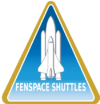Project OV-200
| OV-200 series Space Shuttles | |
 Space Shuttle Upgrade Project logo | |
| Spacecraft Characteristics | |
|---|---|
| Drive Type | x3 ion drives |
| Drive Rating | Variable |
| Primary Manufacturer | Hephaestus Mining and Metalworking, Unltd. (licensee) |
| Owner | Soviet Air Force, Artemis Foundation, Starfleet & others |
| Registry Number | OV-2## |
| Purpose | Variable |
| Other Crew | One AI shipmind |
| Operational Status | Active |
The waving of the Three Graces was by no means the end of the Space Shuttle saga in Fenspace.
Not by a long shot.
Contents
[hide]History
The OV-200 project began with a design study put together by Boeing in mid-2003, shortly after the loss of the Shuttle Columbia. The proposal outlined two possible methods of replacing the destroyed orbiter. The first method, dubbed "OV-106," was basically a rebuild of the original vehicle using remaining structural spares and modern assembly line techniques to minimize construction time. The second method, dubbed "OV-201," proposed a radical upgrade to the Shuttle's internal structure and systems. Boeing suggested using composite framing similar to that on the 787 airliner in as many areas as possible to improve performance, replacing the outdated hydraulic avonics with more modern electric actuators, exchanging the fragile silca thermal protection for the Inconel shingles originally designed for the Venture Star program, significant upgrades to the onboard computers (beyond even what had previously been accomplished in refits), etc. In short, OV-201 was designed to benefit from the thirty-plus years of advances in aerospace engineering since the Shuttle design was frozen in 1974.
The study was abandoned by Boeing not long after it was completed. By that point it had become clear that neither NASA nor the government were looking for a replacement for Columbia and were instead gearing up for retiring the Shuttles by the end of the decade. Despite some interest shown at several aerospace symposiums, the Boeing study was filed away along with the B2707, the Sonic Cruiser and the rest of the stillborn brilliant design ideas.
The 106/201 study resurfaced in 2011, when it was purchased (along with a whole stack of Boeing aircraft and spacecraft designs) by the Soviet Air Force as sort of an impulse buy on the Central Committee's part. The study was worked over by the VVS with an eye towards using it as a guide for refitting Ptichka, modifying some concepts as more practical in Fenspace (an abundance of Venusian carbon composites meant the airframe could be 85% buckytube laminate instead of 50% carbon-reinforced plastic as in the original study, for example) as well as eliminating things that weren't available to a middling fen operation (the use of 100% top-line computer components in the glass cockpit, for example; handwaved consumer-grade electronics would work just as well).
In March 2014 the VVS approached Hephaestus Foundry with the 201 study (now redubbed "OV-200") and an offer to license the design in exchange for a cut of the revenue and one vehicle fresh off the assembly lines. Wire Geek was initially hesitant to agree at first - Space Shuttles being large and time-consuming to build, even if you've got the best industrial setup in Fenspace - but the subsequent purchase of the original Shuttle hardware by Stellvia Corporation changed his mind. With the wealthiest entity in Fenspace now owning a large corps of trained cosmonauts and planning a pretty aggressive expansion into intrasystem science missions, a market for OV-200 Shuttles opened up with a bang.
The first OV-200 Orbiters were unveiled at a public ceremony on Hephaestus in November 2014. The first vehicle, OV-201 Enterprise, was purchased by Starfleet "in order to maintain appropriate heritage." The second, OV-202 Columbia, was purchased by the Soviet Air Force as a lead element for their exploration force.
Vehicles
The OV-200 shows the VVS bias towards designs with minimal amounts of handwavium built in. Compared to the average fenship, an OV-200 orbiter is practically hardtech. Handwavium is used primarily in the propulsion and life support systems, with only a very light application for structural or hull reinforcement. This means that the vehicles are all low-quirk, with most quirks clustering in the onboard AIs.
The Orbiters are built to match NASA specifications unless otherwise requested by the purchaser.
Class Quirks
- Good Morning Starshine II: Similar to the class quirk displayed by the Three Graces, the OV-200 Orbiters need music played at the beginning of each workday in order to function at peak efficiency. Unlike the Graces, the same song can be reused (no more than three times in a row per any given month), but each Orbiter needs a distinct genre of music played for the best possible effect.
The Fleet
Shuttles owned or planned to be ordered by the Artemis Foundation are named after explorer's vessels. The Soviet Air Force fleet uses heavy weather for its Shuttle naming convention, and the Roughriders name Shuttles after mythological flying beasts. Other owners (who usually only own a single Shuttle each) use whatever names strike their fancy.
| Hull Number | Name | Insignia | Launched | Flag | Purpose |
| OV-201 | USS Enterprise |  |
11/05/2014 | Starfleet | Explorer |
| OV-202 | MCU Columbia |  |
11/05/2014 | Soviet Air Force | Explorer |
| OV-203 | Challenger | 02/27/2015 | Artemis Foundation | Research, support for Station McAuliffe | |
| OV-204 | Resolution | 02/27/2015 | Artemis Foundation | Research, support for Station Chawla | |
| OV-205 | Phoenix | 06/11/2015 | Roughriders | Passenger/cargo transport | |
| OV-206 | Daedalus | 07/20/2015 | Station O'Neill | Personal yacht owned by Paidrag O'Niell | |
| OV-207 | Gjøa | 08/01/2015 | Artemis Foundation | Research, support for Station Beta | |
| OV-208 | Uragan | 09/03/2015 | Soviet Air Force | Explorer | |
| OV-209 | Calypso | 10/31/2015 | Artemis Foundation | Research, education | |
| OV-210 | Griffin | 12/12/2015 | Roughriders | Passenger/cargo transport | |
| OV-211 | Moonraker | 01/21/2016 | Principality of Laputa | Personal yacht owned by "an anonymous gentleman" residing on 2 Pallas | |
| OV-212 | Roc | 03/02/2016 | Roughriders | Passenger/cargo transport | |
| OV-213 | Melchizedek | 04/15/2016 | Panzer Kunst Gruppe | General Utility | |
| OV-214 | Nautilus | 06/01/2016 | Robur's Eyrie | Experimental test vehicle | |
| OV-215 | Duyfken | 06/03/2015 | Artemis Foundation | Research, exploration |
| |||||||||||||||||||

